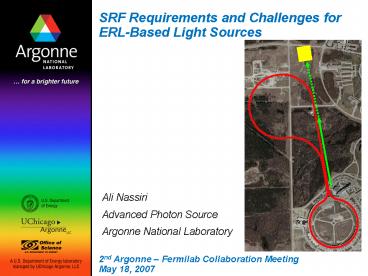SRF Requirements and Challenges for ERL-Based Light Sources - PowerPoint PPT Presentation
1 / 12
Title:
SRF Requirements and Challenges for ERL-Based Light Sources
Description:
SRF Requirements and Challenges for ERL-Based Light Sources Ali Nassiri Advanced Photon Source Argonne National Laboratory 2nd Argonne Fermilab Collaboration Meeting – PowerPoint PPT presentation
Number of Views:85
Avg rating:3.0/5.0
Title: SRF Requirements and Challenges for ERL-Based Light Sources
1
SRF Requirements and Challenges for ERL-Based
Light Sources
- Ali Nassiri
- Advanced Photon Source
- Argonne National Laboratory
2nd Argonne Fermilab Collaboration MeetingMay
18, 2007
2
Acknowledgements
- APS
- M. Borland, J. Carwardine, Y. Chae, G. Decker,
L. Emery, R. Gerig, E. Gluskin, - K. Harkay, R. Kustom, V. Sajaev, N. Sereno, C.
Yao, Y. Wang, M. White - JLAB
- G. Krafft, L. Merminga, R. Rimmer,
3
Outline
- Introduction
- SRF Requirement and Challenges
- Summary
4
Introduction
- Energy Recovery Linac (ERL) is a potential viable
revolutionary option for future light sources. - Argonne Advanced Photon Source is considering
ERL for its upgrade - Promise of very high brightness and transverse
coherence - Extremely low emittance, equal in both planes
- Very low energy spread
- Picosecond pulses
- Option for less current with high charge,
femtosecond pulses.
5
A Design Parameters Comparison
ILC1
Light Source ERL2
Beam Energy 500 COM 5 8 GeV
Average beam Current 9.0 100 mA
Bunch train repetition rate 5 1.3?109 Hz
RF duty factor 7.5?10-3 - 1?10-2 CW
Average accelerating gradient 31.5 20 MV/m
Cavity Quality factor 1?1010 gt 5?1010 (1?1011)
Beam pulse length 9.5?10-4 2?10-12 sec
Total AC power consumption 230 50 MW
1 Barry Barish, GDE/ACFA Closing Beijing
7/02/07 2 Ali Nassiri, APS MAC, Nov. 15-16,2006
6
SRF requirements
- 7 GeV single pass cw linac
- 400 multi-cell SRF cavities for main linac
- Roughly 400 meter of rf linac
- 10 MeV, 100 mA Injector linac ( 1 MW RF power)
- Roughly 45 kW total losses ( dynamic and static
losses) at 20K - Large complex
- Extremely heavy cryogenic load
- Robust and reliable power couplers (FPC) and HOM
dampers - Complex low-level rf control for amplitude, phase
stability and microphonics - Acceptable RF systems reliability and
availability for beam up time
7
Cavity Main Parameters
Parameter Unit Value
Frequency MHz 1300/1408/704
Accelerating mode TM010 ? mode
Gradient MV/m 18/20
Quality factor Q0 2?1010 /1?1011
Number of cells 9/7/5 ( HOM problem)
R/Q ? 900/1200
Qext for input coupler 1?107
Cavity bandwidth at Qext Hz 400
Fill time ?s 500
- Multi-cell cavities with a larger number of
- cells would also improve linac packing
factor, - i.e., ratio of active length to total length
- This will reduce the cost of the ERL linac, BUT
- Strong HOM damping is essential with higher
- beam current which favors smaller number
- of cells
(per cavity for two beams)
8
Superconducting modules for ERLs
- Superconducting modules for high average current
ERL operation have not been yet been
demonstrated. - Issues ( among others) that must be addressed
are - CW operation resulting in fairly high dynamic and
static heat loads. - High-current operation and the resultant large
HOM power that must be extracted to limit the
cryogenic load and to ensure stable beam
conditions (100s of watts)1. - Small bandwidth operation ( almost negligible net
beam loading), which makes the cavity operation
particularly susceptible to microphonic detuning - More rf power
- More complex LLRF system and controls
1 Ali Nassiri, APS MAC, Nov. 15-16,2006
9
Cavity Designs for ERLs
- Effect of residual resistance on AC power
consumption ( non-BCS surface resistance)
With state-of-the-art 7 n? residual resistance
With ideal 1 n? residual resistance
Multi parameters cost optimization is extremely
important.
Temperature dependent of Carnot efficiency of
the cryoplant is included.
10
Quality factor
- To reduce refrigeration power, cavity quality
factor should be improved - ERLs need higher Q0 at moderate gradients
- Gradients of 15 to 20 MV/m is reasonable. It
avoids field emission.
- To reduce refrigeration power, cavity quality
factor should be improved - ERLs need higher Q0 at moderate gradients
- Gradients of 15 to 20 MV/m is reasonable. It
avoids field emission.
?
?CEBAF spec.
?CEBAF 12 GeV project spec.
?
? ERL design goal
?
Single-cell 1.3 GHz cavity tested at 1.6K at
Saclay
11
Summary
- SCRF technology for CW machines is advancing at a
fast pace. - The fundamental principles of ERLs have been
established. - Technical challenges are
- Cryogenic design for ERL needs a new approach to
improve refrigeration efficiency to reduce plant
construction and operation costs. - Design a high current CW-specific cryomodule to
meet ERL design parameters requirement. - Develop a robust HOM damping system for high
average beam current operation - Better understanding of field emission for high
gradient in CW mode - Improve cavity quality factor ( 1?1011)
- For CW operation highest fields are not
important. Highest possible Q values at about 20
MV/m are very critical. - We are carefully considering the challenges
presented by the ERL upgrade - CW-SRF technology RD program for ERL will
benefit from ANL-FNAL active collaboration - We are ready to start
12
Acknowledgements
- M. Borland, J. Carwardine, G. Decker, L. Emery,
R. Gerig, K. Harky, V. Sajaev, N. Sereno, M. White































